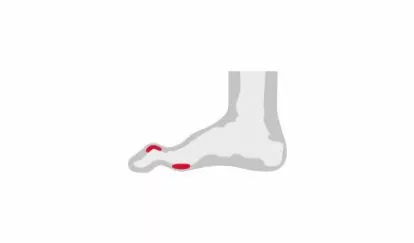SKEWFOOT

Skewfoot – description
Virtually half of all adults show symptoms of Skewfoot (also known as Serpentine Foot), meaning that the heels are overproportionately at a slant to the ground instead of being straight. As a result, the heels are at a slant instead of bearing any strain perpendicular to the ground, and the Achilles heel is at a slant. This causes disorders in the arch of the foot on the one hand, and the leg axis is typically turned inwards as a result. This is also commonly known as knock knees. The medial (inner) arch of the foot is flattened too. The inner edge of the foot tilts towards the ground whilst the outer edge is raised. Consequently, muscles and ligaments are put under undue stress due to the abnormal strain, which is particularly the case with the inside of the knee and medial meniscus. As a result, the pelvis of those with Skewfoot is often tilted forward, which the spine attempts to compensate for by forming a hollow back. This often leads to the persons affected suffering from headaches and neck pain, and reconfirms what we said earlier on, notably that problems associated with the feet often have far-reaching implications, far removed from the foot. Indeed, Skewfoot can result in experiencing concentration problems which, in turn, can cause an overall impairment in performance. The human body should not be underestimated in its complexity. When all is said and done, a healthy foot can mean the difference between a healthy or unhealthy body.
Skewfoot - causes
Skewfoot is normal in children and is overcome as they grow older. Among adults, the cause is frequently an imbalance in weight distribution and existing muscle power (e.g. due to very little movement combined with obesity) as well as improper strain on the foot or unstable shoes. Nevertheless, injuries or inflammatory diseases can also be the cause too.
Skewfoot - treatment
A flat-valgus foot is, to a certain degree, quite normal in a child, and generally disappears in time. Consequently, children are encouraged to go barefoot (as are adults, too) and to wear comfortable and flexible shoes, which do not cramp the feet – even if they do not have any signs of deformity. If Skewfoot leads to problems or pain suffered as an adult, it is recommended to ask for orthopaedic inlays on prescription and actively take part in foot gymnastics (grasping exercises with the toes and standing on tiptoe).
 DE
DE EN
EN FR
FR NL
NL









